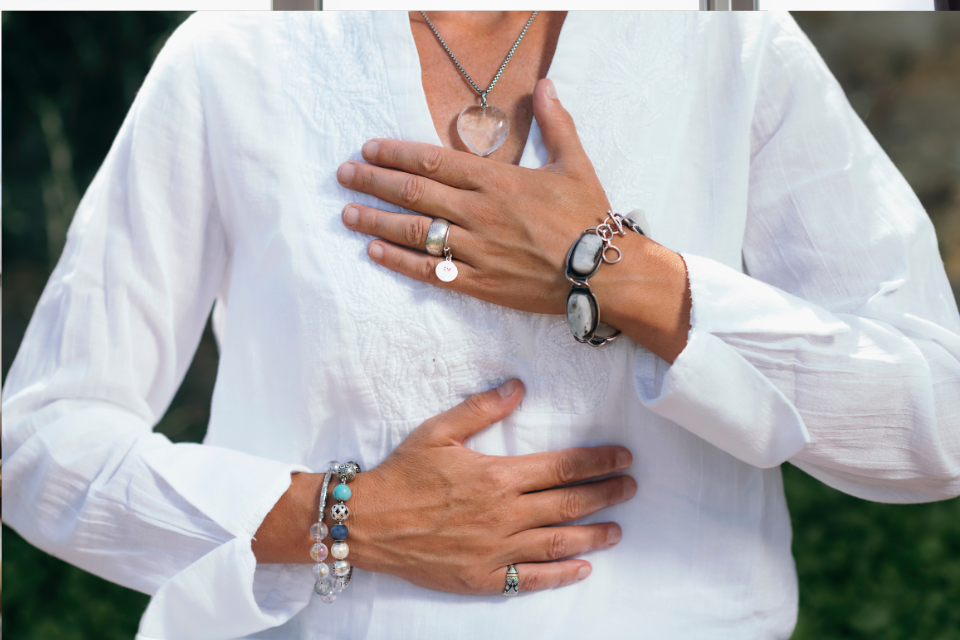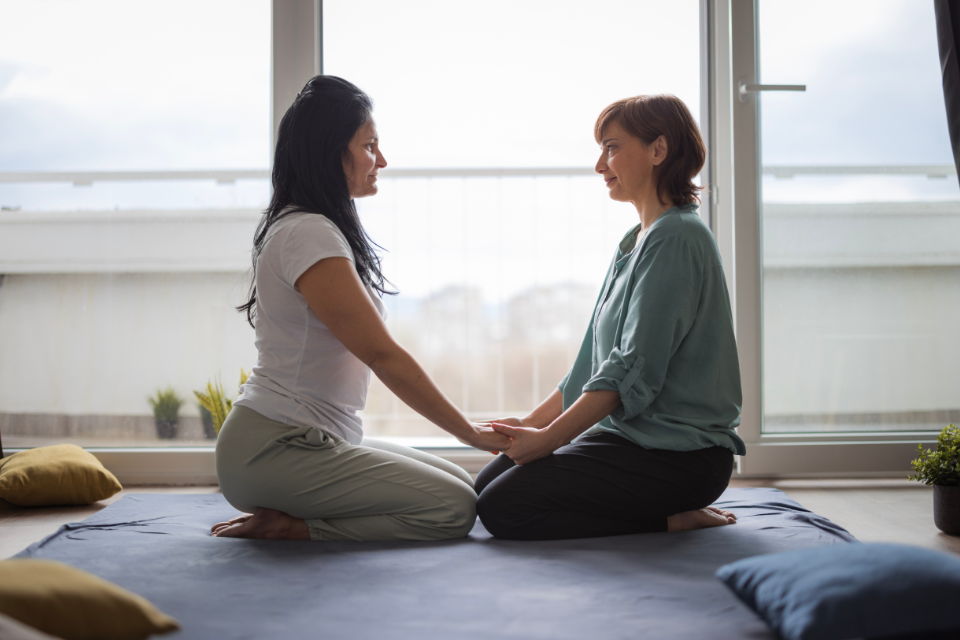Guided Meditation for Anxiety: Find Your Calm Place

Let’s be honest for a second. When you’re in the thick of it heart hammering against your ribs, thoughts racing like a runaway train, a cold dread pooling in your stomach the last thing you probably want to hear is "just relax" or "try meditating." It can feel like being told to put out a house fire with a water pistol. It sounds simplistic, maybe even a little dismissive.
I get it. I really do. The anxiety monologue is a powerful one. It’s convincing. It tells you that you need to think your way out of the problem, to worry it into submission. But what if the way out isn’t through more thinking, but through… less?
This isn't about chanting on a mountaintop or achieving some mythical state of perpetual bliss. It's about finding a fire escape. It's about learning to turn down the volume on the internal noise, even just for a few minutes. This is where a practical mindfulness practice for anxiety comes in, not as a magic cure, but as a tool. A real, functional tool you can use when everything feels like it’s falling apart.
We’re going to walk through this together, exploring a specific and incredibly gentle technique: using a guided meditation for anxiety to find and build your own mental sanctuary. We'll even get into the nuts and bolts with a full meditation script for anxiety you can use, adapt, or just borrow from. Think of this as less of a lecture and more of a conversation about reclaiming a little piece of your own mind.
Why Does My Brain Feel Like It’s Attacking Me?
Before we get into the "how," it helps to understand the "why." Anxiety, at its core, is your body's alarm system the fight-or-flight response going off at the wrong time. It’s a primitive survival mechanism that’s supposed to save you from a saber-toothed tiger, but it’s being triggered by a looming work deadline, a crowded grocery store, or sometimes, seemingly nothing at all.
Your brain gets stuck in a loop. A worry pops up. Your body reacts with physical symptoms (tight chest, shallow breathing). Your brain notices these symptoms and thinks, "See? I told you there was a danger!" which, of course, creates more worry. And around and around we go.
Meditation, particularly the kinds we're talking about, is designed to interrupt this cycle. It does a couple of things:
- It activates the relaxation response: This is the physiological opposite of fight-or-flight. Your heart rate slows, your breathing deepens, and your muscles begin to release tension.
- It creates distance from your thoughts: This is the core of mindfulness. You learn to observe your anxious thoughts without immediately getting swept away by them. You see them as just… thoughts. Not objective reality. Not direct orders. Just mental weather passing through.
It seems almost too simple to work, I know. But by consistently practicing, you’re training your brain to react differently. You’re carving out a new neural pathway one that leads to quiet instead of panic.
The Power of a Guide: Why Guided Meditation Works Wonders for Anxiety
Starting meditation with an anxious mind can be a frustrating experience. You sit down, close your eyes, and are immediately ambushed by a tidal wave of worries, to-do lists, and self-criticism. It can feel like you’re failing before you’ve even started.
This is where a guided meditation for anxiety becomes your best friend. Instead of leaving you alone in the dark with your thoughts, it gives your restless mind a job to do: listen.
A calm, steady voice guides you through the process, telling you where to place your focus on your breath, on a part of your body, or, as we'll explore, on a peaceful image. This external anchor is a lifeline. It gives you something to hold onto when your thoughts try to pull you under. It's like having a seasoned hiking guide lead you through a dense, unfamiliar forest. You’re still doing the walking, but you don’t have to worry about getting lost.
Finding Your Sanctuary: The Essence of Calm Place Meditation
One of the most powerful techniques used in guided sessions for anxiety is visualization, specifically the creation of a "calm place" or "safe place." It’s a cornerstone of what I like to call calm place meditation.
The idea is simple: you create a detailed, vivid sanctuary in your mind a place you can retreat to whenever you feel overwhelmed. This isn’t about escaping reality forever. It’s about giving your nervous system a much-needed break so you can return to reality with more resilience.
Your calm place is uniquely yours. It’s not about what you think should be calming, like a generic beach from a travel poster. It has to resonate with you on a personal level. Maybe it’s:
- A cozy armchair by a crackling fireplace in a secluded cabin.
- A sun-drenched, mossy spot in a quiet forest.
- The porch of a house you loved as a child, listening to the rain.
- Floating weightlessly in calm, clear water.
- Even a futuristic, minimalist room with a comfortable pod and a view of the stars.
The key is to engage as many senses as possible. What do you see? What do you hear? What does the air smell like? Is it warm or cool on your skin? The more detailed and sensory-rich it is, the more "real" it will feel to your brain, and the more effective it will be at triggering that all-important relaxation response.
Actually, come to think of it, the first time I tried this, I felt a bit silly. I was trying to imagine a beach, but my brain kept adding things like crowds and seagulls trying to steal my non-existent chips. It didn't work until I switched to something that was genuinely mine the memory of my grandfather's quiet, tool-filled workshop. The smell of sawdust and old oil was, for me, the smell of safety. So, don't be afraid to get specific and a little weird.
A Step-by-Step Guide to Creating Your Calm Place
Ready to try and find yours? Let's walk through it. You can do this as a standalone exercise or as a prelude to the longer script below.
- Brainstorm (No Pressure): Just take a moment. Think of any place, real or imagined, where you have felt or could imagine feeling completely at peace and safe. Don't overthink it. Let the first few ideas just come to you.
- Choose One and Get Comfortable: Pick one image that feels the most inviting right now. Find a quiet place to sit or lie down, where you won't be disturbed for a few minutes. Close your eyes if that feels comfortable.
- Start with the Senses - Sight & Sound: Begin to build the scene in your mind. What are the first things you see? The colors, the light, the shapes? Now, listen. Is there a sound? Maybe it’s the gentle rustle of leaves, the hum of a distant lawnmower, or complete, perfect silence.
- Engage Touch and Smell: What does the air feel like on your skin? Is it warm, cool, breezy? What are you sitting or standing on? Feel the texture. Now, what do you smell? Damp earth? Salty air? Fresh laundry?
- Add a Feeling of Safety: This is the most important part. As you build this place in your mind, intentionally introduce the feeling of safety. You can even say to yourself, "I am completely safe here. This is my place." Let that feeling of calm spread through your body.
- Anchor It: Spend a few minutes just being in your place. When you're ready to leave, take a mental snapshot. Maybe even create a "trigger word" for it, like "sanctuary," "cabin," or "quiet." The idea is to create a shortcut, so with practice, just thinking your word can start to bring back the feeling of your calm place.
This process itself is a powerful mindfulness practice for anxiety. You are focusing your attention, grounding yourself in sensory details, and consciously choosing a state of calm.
A Complete Meditation Script for Anxiety: Your Journey to the Calm Place
Here is a full script you can use. You might want to record yourself reading it slowly and calmly on your phone, or have someone else read it to you. Remember to leave pauses (indicated by ...) where you can breathe and let the words sink in.
This script is a template. Feel free to change the details to better match the calm place you’ve started to build for yourself.
(Begin Script)
Find a comfortable position, either sitting upright with your back supported and your feet flat on the floor, or lying down on your back. Whatever feels best for your body right now.
...
Allow your eyes to gently close, or if you prefer, just soften your gaze and look down towards the floor.
...
Let’s start by just arriving here. Noticing the weight of your body, supported by the chair or the floor beneath you. Feeling the points of contact.
...
Bring your awareness to your breath, without any need to change it. Just noticing the gentle rise of your chest or belly on the in-breath... and the gentle fall on the out-breath.
...
Following the air as it enters your body... and as it leaves. Each breath is an anchor to this present moment. If your mind wanders, and it probably will, that’s perfectly okay. That’s what minds do. Just gently, without judgment, guide your attention back to the rhythm of your breathing.
...
Now, I want you to begin to imagine your calm place. The place we talked about. Your own personal sanctuary. It doesn’t have to be perfect. Just allow a gentle image to form in your mind.
...
Maybe you start by seeing the light... is it the soft, golden light of late afternoon? The cool, clear light of morning? Or the gentle glow of a fireplace?
...
Look around your calm place. Notice the details. The colors... the textures... the shapes... Take your time. There is no rush here.
...
Now, bring your awareness to the sounds of your safe place. Perhaps you hear the gentle whisper of the wind... the distant sound of water... or a deep, comforting silence. Whatever you hear, just let those sounds wash over you, deepening your sense of peace.
...
What can you feel? Feel the temperature of the air on your skin. Feel the surface beneath you... is it soft grass, warm sand, a comfortable chair? Let your body feel truly supported by this place.
...
And what do you smell? Is there a scent in the air? The smell of rain on dry earth... of pine needles... of something baking in an oven long ago. Let this scent fill you with a sense of well-being and safety.
...
Take a moment now to just be in this place. Breathing in the calm of your sanctuary... and breathing out any tension, any worry.
...
You are the creator of this place, and here, you are completely safe. You are in control. Nothing and no one can harm you here. Allow that feeling of deep security to settle into your bones. Feel it in your chest... in your shoulders... down your arms and into your hands.
...
If any anxious thoughts or feelings arise while you’re here, that's alright. You can acknowledge them, almost like watching clouds drift across the sky of your calm place. You don't have to get on board with them. You can just let them drift on by, returning your focus to the sights... the sounds... and the feeling of your sanctuary.
...
Breathing in peace... and breathing out noise.
...
Spend a few more moments here, soaking in this feeling of deep calm and quiet. Know that you can return to this place whenever you need to. It is a part of you. It is always here, waiting for you.
...
Now, it’s time to slowly and gently begin the journey back to the room.
...
Keeping the feeling of calm with you, slowly bring your awareness back to your physical body. Notice the feeling of the chair or the floor beneath you again.
...
Become aware of the sounds in the room around you.
...
When you feel ready, you can begin to gently wiggle your fingers and your toes. Maybe take a gentle stretch.
...
And only when you’re ready, slowly and gently, open your eyes. Take a moment before you move. Just notice how you feel.
(End Script)
Making It a Practice: Beyond the Script
Using this meditation script for anxiety is a wonderful first step, but the real, lasting change comes from building a consistent mindfulness practice for anxiety. This doesn't mean you need to do this hour-long meditation every single day. It means weaving moments of mindfulness into the fabric of your life.
Here’s a comparison of how these elements can work together:
| Practice Type | When to Use It | Key Benefit |
| Full Guided Meditation | 2-4 times a week, or when you feel anxiety building and have 15-20 minutes. | Deeply resets the nervous system, builds resilience over time. |
| Quick Calm Place Visit | In a moment of acute stress (e.g., before a meeting, in traffic). (1-3 mins) | Provides an immediate "circuit breaker" for panic and overwhelming feelings. |
| Everyday Mindfulness | Throughout your day, during routine activities. (30 seconds at a time) | Trains your brain to stay in the present moment, preventing anxiety loops. |
What does "Everyday Mindfulness" even look like? It’s simpler than you think.
- Mindful Dishwashing: Instead of letting your mind race, focus completely on the task. Feel the warm water on your hands, see the soap bubbles, hear the clink of the plates.
- Mindful Walking: Feel your feet hitting the pavement. Notice the rhythm of your steps. Look at the trees you pass without labeling them, just seeing them.
- The Three-Breath Pause: Several times a day, just stop. Take one deep breath in and out. Then a second. Then a third. That's it. You've just practiced mindfulness.
These small moments are like doing reps at the gym. They strengthen your "mindfulness muscle," making it easier to access that state of calm when you really need it. The calm place meditation becomes easier to access. The anxious thoughts have a little less grip. It all works together.
It's a process. Some days will be easier than others. Some days, your mind will feel like a hornet’s nest, and that's okay. The goal isn’t perfection; it’s practice. Every time you sit down, every time you pause to take a breath, you are sending a powerful message to your nervous system: "I can be in charge here. I can be quiet. I can be safe." And in the roaring silence you create, you might just find the peace you’ve been looking for.
Frequently Asked Questions (FAQ)
1. What if I can't visualize anything? Does that mean it's not working?
Not at all! Many people are not strongly visual. If creating a picture in your mind is difficult, focus more heavily on the other senses. What would your calm place feel like? Focus on the sensation of warmth, coolness, or a gentle breeze. What would it sound like? Focus on silence, or the sound of your own steady breathing. The goal is to evoke a feeling of calm and safety, and you can absolutely do that without a perfect mental movie.
2. How long will it take for this guided meditation for anxiety to actually help?
This is a very common and fair question. It's not an overnight fix, and the effects can be both immediate and cumulative. You might feel a sense of relief and calm right after your very first session. The more lasting changes like a general reduction in your baseline anxiety levels come with consistency. Think of it like physical exercise. You feel good after one workout, but the real health benefits come from making it a regular practice. Many people report noticing a real difference in their daily anxiety after practicing consistently for a few weeks.
3. Is it okay to fall asleep during the meditation?
Yes, it's perfectly fine. In fact, it's a sign that your body is finally getting the deep rest it needs! Your nervous system is shifting into the "rest and digest" state, which is the whole point. If your goal is specifically to train your mind to be aware, you can try practicing in a more upright, seated position to reduce the likelihood of sleep. But if you doze off, don't worry about it. Your body is still getting immense benefit.
4. Can I do this without a script?
Absolutely. The meditation script for anxiety is like training wheels. It’s there to support you as you learn. As you become more familiar with the process and more confident in your ability to guide yourself, you can start to rely on it less and less. Eventually, you'll be able to simply close your eyes, take a few deep breaths, and transport yourself to your calm place without any external guidance at all. That is the ultimate goal to empower you with a tool you can use anytime, anywhere.


